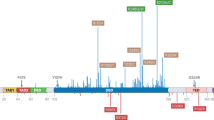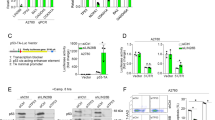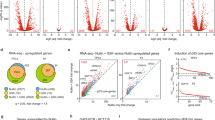Abstract
In the present work, we show that mithramycin A, a drug that is currently used for the treatment of patients with Paget's disease of the bone as well as with several forms of cancer, is a strong activator of the tumor suppressor p53 protein in human hepatoma cells. The time course of p53 activation by mithramycin A was similar to the known chemotherapeutic compound 5-fluorouracil (5-FU). Both 5-FU and mithramycin A induced site-specific phosphorylation of p53 at serine 15. However, in contrast to 5-FU, mithramycin A failed to activate p53 target genes including the cell cycle inhibitor p21Cip1 gene as well as the proapoptotic genes PUMA (p53-upregulated mediator of apotosis) and BAK (bcl2-homologous antagonist/killer) and blocked the induction of the above genes by 5-FU. Using transactivation assays in Sp1-deficient cells, we showed that mithramycin A inhibited the transcriptional activation of the p21Cip1 and PUMA promoters by Sp1 and p53. Using chromatin immunoprecipitation assays and a novel protein–protein interaction assay based on biotinylation in vivo, we established that 5-FU enhanced the formation of p53–Sp1 complexes in solution and the subsequent recruitment of both factors to the p21Cip1 promoter. Mithramycin A also enhanced the recruitment of p53 to the distal p21Cip1 promoter but totally blocked the recruitment of Sp1 to the proximal p21Cip1 promoter. Our findings suggest that inhibition of Sp1 binding to the promoters of several p53 target genes, such as the p21Cip1 gene as well as certain proapoptotic genes, by mithramycin A, prevents the transcriptional induction of these genes by p53 and propose a mechanism that could account for some of the tumor suppressing and antiapoptotic effects of mithramycin A.
This is a preview of subscription content, access via your institution
Access options
Subscribe to this journal
Receive 50 print issues and online access
$259.00 per year
only $5.18 per issue
Buy this article
- Purchase on Springer Link
- Instant access to full article PDF
Prices may be subject to local taxes which are calculated during checkout







Similar content being viewed by others
Abbreviations
- 5-FU:
-
5-fluorouracil
- ARP-PO:
-
acidic ribosomal phosphoprotein
- BAK:
-
bcl2-homologous antagonist/killer
- BSA:
-
bovine serum albumin
- ChIP:
-
chromatin immunoprecipitation
- CMV:
-
cytomegalovirus
- DMEM:
-
Dulbecco's modified Eagle's medium
- FBS:
-
fetal bovine serum
- GST:
-
glutathione S transferase
- NP-40:
-
Nonidet P-40
- PAGE:
-
polyacrylamide gel electrophoresis
- HRP:
-
horseradish peroxidase
- PBS:
-
phosphate-buffered saline
- PCR:
-
polymerase chain reaction
- PUMA:
-
p53-upregulated mediator of apoptosis
- WB:
-
Western Blotting
- wt:
-
wild type
- WCE:
-
whole cell extracts
References
Aich P and Dasgupta D . (1995). Biochemistry, 34, 1376–1385.
Blume SW, Snyder RC, Ray R, Thomas S, Koller CA and Miller DM . (1991). J. Clin. Invest., 88, 1613–1621.
Brown JH and Kennedy BJ . (1965). N. Engl. J. Med., 272, 111–118.
Cheng M, Olivier P, Diehl JA, Fero M, Roussel MF, Roberts M and Sherr CJ . (1999). EMBO J., 18, 1571–1583.
Choi J and Donehower LA . (1999). Cell Mol. Life Sci., 55, 38–47.
de Boer E, Rodriguez P, Bonte E, Krijgsveld J, Katsantoni E, Heck A, Grosveld F and Strouboulis J . (2003). Proc. Natl. Acad. Sci. USA, 100, 7480–7485.
de Siervi A, Marinissen M, Diggs J, Wang XF, Pages G and Senderowicz A . (2004). Cancer Res., 64, 743–750.
Dotto GP . (2000). Biochim. Biophys. Acta, 1471, M43–M56.
Elias EG and Evans JT . (1972). J. Bone Joint Surg., 54-A, 1730–1736.
Gartel AL and Tyner AL . (2002). Mol. Cancer Ther., 1, 639–649.
Hall PA, Campbell SJ, O'neill M, Royston DJ, Nylander K, Carey FA and Kernohan NM . (2000). Carcinogenesis, 21, 153–160.
Hall TJ, Schaeublin M and Chambers TJ . (1993). Biochem. Biophys. Res. Commun., 195, 1245–1253.
Harper JW and Elledge SJ . (1996). Curr. Opin. Genet. Dev., 6, 56–64.
Harper JW, Elledge SJ, Keyomarsi K, Dynlacht B, Tsai LH, Zhang P, Dobrowolski S, Bai C, Connell-Crowley L, Swindell E, Fox MP and Wei N . (1995). Mol. Biol. Cell, 6, 387–400.
Hatzis P and Talianidis I . (2001). Mol. Cell. Biol., 21, 7320–7330.
Jayasuriya H, Lingham RB, Graham P, Quamina D, Herranz L, Genilloud O, Gagliardi M, Danzeisen R, Tomassini JE, Zink DL, Guan ZQ and Singh SB . (2002). J. Nat. Prod., 65, 1091–1095.
Kardassis D, Falvey E, Tsantili P, Hadzopoulou-Cladaras M and Zannis VI . (2002). Biochemistry, 41, 1217–1228.
Kardassis D, Pardali K and Zannis VI . (2000). J. Biol. Chem., 275, 41405–41414.
Kardassis D, Zannis VI and Cladaras C . (1992). J Biol Chem., 267, 2622–2632.
Kohn KW . (1999). Mol. Biol. Cell, 10, 2703–2734.
Koutsodontis G, Moustakas A and Kardassis D . (2002). Biochemistry, 41, 12771–12784.
Koutsodontis G, Tentes I, Papakosta P, Moustakas A and Kardassis D . (2001). J. Biol. Chem., 276, 29116–29125.
Kuo MH and Allis CD . (1999). Methods, 19, 425–433.
Ladias JA, Hadzopoulou-Cladaras M, Kardassis D, Cardot P, Cheng J, Zannis VI and Cladaras C . (1992). J. Biol. Chem., 267, 15849–15860.
Lehman TA, Modali R, Boukamp P, Stanek J, Bennett WP, Welsh JA, Metcalf RA, Stampfer MR, Fusenig N and Rogan EM . (1993). Carcinogenesis, 14, 833–839.
Levine AJ . (1997). Cell, 88, 323–331.
Longley DB, Harkin DP and Johnston PG . (2003). Nat. Rev. Cancer., 3, 330–338.
Majee S and Chakrabarti A . (1999). Biochem. Pharmacol., 57, 981–987.
Majee S, Dasgupta D and Chakrabarti A . (1999). Eur. J. Biochem., 260, 619–626.
Miller DM, Polansky DA, Thomas DD, Ray R, Campbell VW, Sanchez J and Koller CA . (1987). Am. J. Med. Sci., 294, 388–394.
Moustakas A and Kardassis D . (1998). Proc. Natl. Acad. Sci. USA, 95, 6733–6738.
Nehls MC, Brenner DA, Gruss HJ, Dierbach H, Mertelsmann R and Herrmann F . (1993). J. Clin. Invest., 92, 2916–2921.
Orlando V . (2000). Trends Biochem. Sci., 25, 99–104.
Pardali K, Kurisaki A, Moren A, ten Dijke P, Kardassis D and Moustakas A . (2000). J. Biol. Chem., 275, 29244–29256.
Ray R, Snyder RC, Thomas S, Koller CA and Miller DM . (1989). J. Clin. Invest., 83, 2003–2007.
Remsing LL, Bahadori HR, Carbone GM, McGuffie EM, Catapano CV and Rohr J . (2003). Biochemistry, 42, 8313–8324.
Ryan WG, Schwartz TB and Northrop G . (1970). J. Am. Med. Assoc., 213, 1153–1157.
Schavinsky-Khrapunsky Y, Huleihel M, Aboud M and Torgeman A . (2003). Oncogene, 22, 5315–5324.
Schneider I . (1972). J. Embryol. Exp. Morphol., 27, 353–365.
Seoane J, Le HV and Massague J . (2002). Nature, 419, 729–734.
Snyder RC, Ray R, Blume S and Miller DM . (1991). Biochemistry, 30, 4290–4297.
Strano S, Fontemaggi G, Costanzo A, Rizzo MG, Monti O, Baccarini A, Del Sal G, Levrero M, Sacchi A, Oren M and Blandino G . (2002). J. Biol. Chem., 277, 18817–18826.
Vogelstein B, Lane D and Levine AJ . (2000). Nature, 408, 307–310.
Yu J, Wang Z, Kinzler KW, Vogelstein B and Zhang L . (2003). Proc. Natl. Acad. Sci. USA, 100, 1931–1936.
Yu J, Zhang L, Hwang PM, Kinzler KW and Vogelstein B . (2001). Mol. Cell, 7, 673–682.
Zhang H, Hannon GJ, Casso D and Beach D . (1994). Cold Spring Harb. Symp. Quant. Biol., 59, 21–29.
Zhang H, Xiong Y and Beach D . (1993). Mol. Biol. Cell, 4, 897–906.
Acknowledgements
We thank Antigoni Kouskouti and Iannis Talianidis (IMBB-FORTH, Heraklion) for their help and advice in the chromatin immunoprecipitation experiments, Paraskevi Papakosta for expert technical assistance and other members of the Kardassis lab for helpful suggestions and discussions. We also thank Dr Vassilis Zannis (University of Crete and IMBB-FORTH, Heraklion) for various reagents used in this study and Dr Aris Moustakas (LICR-Uppsalsa) for helpful comments and discussions. This work was supported by a grant from the Ministry of Education of Greece (PENED-2001) and by internal funds from the Institute of Molecular Biology and Biotechnology of Crete to DK.
Author information
Authors and Affiliations
Corresponding author
Rights and permissions
About this article
Cite this article
Koutsodontis, G., Kardassis, D. Inhibition of p53-mediated transcriptional responses by mithramycin A. Oncogene 23, 9190–9200 (2004). https://doi.org/10.1038/sj.onc.1208141
Received:
Revised:
Accepted:
Published:
Issue Date:
DOI: https://doi.org/10.1038/sj.onc.1208141
Keywords
This article is cited by
-
Screening of Natural Products and Approved Oncology Drug Libraries for Activity against Clostridioides difficile
Scientific Reports (2020)
-
Mithramycin A suppresses basal triple-negative breast cancer cell survival partially via down-regulating Krüppel-like factor 5 transcription by Sp1
Scientific Reports (2018)
-
Identification of miRNA-mRNA Modules in Colorectal Cancer Using Rough Hypercuboid Based Supervised Clustering
Scientific Reports (2017)
-
Modulation of specificity protein 1 by mithramycin A as a novel therapeutic strategy for cervical cancer
Scientific Reports (2014)
-
Therapeutic effects of the Sp1 inhibitor mithramycin A in glioblastoma
Journal of Neuro-Oncology (2011)



